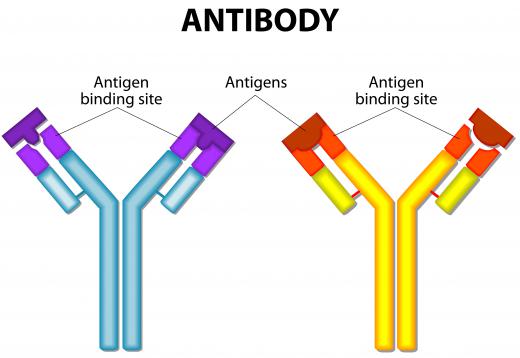What is Antibody Staining?
 Mary McMahon
Mary McMahon
Antibody staining is a laboratory procedure used to stain a sample to detect the presence of certain antigens in a sample or to highlight antigens so that they can be clearly viewed. There are a number of different antibody staining procedures that can be used, depending on the sample and the preference of the technician. This technique is taught at the college and university level in many regions, and in high schools with advanced science programs, students may also learn antibody staining.
In antibody staining, an antibody is introduced to a sample such as a scraping or biopsy. If there are antigens in the sample that the antibody will react to, it locks on to them. When the sample is washed, the excess antibodies will be washed away, leaving behind the antibodies that locked to the sample. If the researcher is using conjugated antibodies with attached fluorescent tags, the sample will light up under the proper illumination, betraying the presence of the antibodies in question.

In other cases, people must use a secondary antibody. After washing the sample, they add the secondary antibody, a preparation with a fluorescent tag attached. The secondary antibody attaches itself to the primary antibodies in the sample, and will fluoresce under light as discussed above. The fluorescence can be used in diagnosis of disease, with lab technicians checking samples for antigens associated with specific diseases, and it can also be used to look for signs of contamination and to identify the presence of antigens for other reasons.

In microscopy, antibody staining can sometimes be helpful for highlighting certain structures. Even with excellent resolution, microscopy can sometimes be difficult to view, and it can be challenging to pick out hidden or small structures in the image. Using antibody staining allows people to create a flag to easily identify and outline structures of interest, such as particular types of tissue or structures inside cells. The fluorescence will be seen at all locations on the slide where the antibody of interest is present, mapping out structures in the sample.
Antibody staining requires access to lab equipment, antibodies, and various solutions used during the process of fixing and preserving samples. It is important to perform the procedure properly to avoid contamination and mistakes like allowing solutions to sit on a sample too long, obscuring or confusing the results. Many labs have a manual that their staff members follow, and when preparing materials for research, people will describe their methods in detail so that their work can be replicated.
AS FEATURED ON:
AS FEATURED ON:












Discussion Comments
I am 50 years old and I've been diagnosed with hyperthyroidism for about for years now and I take carbimazole. Before the diagnosis and even after, I had urticaria for 23 years. I noticed the separation of my nails from my nail bed when I was about twelve years and my nails look horrible and everyone attributed it to nail biting, though I had already stopped nail biting.
When I was pregnant with my second child, I was told I had blood cell antibody M.-- this was 17 years back. I itch most times and have swollen lips sometimes, too. No antihistamine gives me enough relief. I'm suffering but doctors haven't been able to pinpoint anything other than urticaria and hyperthyroid. Kindly help me, please.
Post your comments